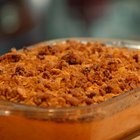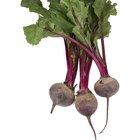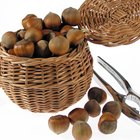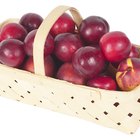
Many cakes require the exercise of great skill and perfect technique to produce a rich, soft, moist result. Carrot cake isn't one of those. It's a relatively easy thing to bake, similar to coffee cakes and other quick cakes in its preparation. The richness and sweetness come partially from fat and sugar, as with other cakes, but partially from the shredded carrots that give it its name. Shredding your carrots is the only part of the process that's especially messy or time consuming, so feel free to do that part a day ahead.
A Quick Food Safety Note
Before you jump right in and start shredding, take a moment to ensure the safety of your carrots. A range of bacteria live in soils, most of them harmless, but others decidedly less so. The skin of your carrots could contain a substantial population of unwelcome guests such as E. coli or salmonella, so scrub them under running water before you start. Otherwise, your peeler will transport them from the carrot's skin to the juicy, freshly exposed interior. When you shred the carrots, you'd be creating a lush and nourishing environment for the bacteria to spread. Carrots aren't an innately high-risk food, but it's worth the few extra seconds to be sure.
Shredding the Carrots
Once your carrots are washed and peeled, you're ready to begin. Most recipes assume you'll use coarsely-shredded carrots from the large side of your box grater, leaving visible threads of carrot in the finished cake. A few specify finely shredded carrot, using the small side of the grater. Those create a more uniform cake and release more juice to give the cake an appealing golden color. If you own a food processor, you can save time and reduce the risk to your knuckles by using it to shred the carrots. Carrots shredded in the food processor will release slightly more juice, making a darker cake.
Refrigerator Time
You can store the shredded carrots overnight in a container or a bag, whichever is more convenient. They'll usually leave a small puddle of juice in the bottom, which can just be poured into your mixing bowl the next day. Storing the carrots for more than a day can be problematic. Their juice is high in natural sugars, and the carrots usually contain some wild yeast from the surrounding air. Given an extra day or more to reproduce, those wild yeasts can quickly ferment your carrots and make them unusable.
Just to Have on Hand
If you like to have the option of whipping up a carrot cake on a whim, you can freeze the shredded carrots instead. Measure the correct amount for your recipe and pack it into an airtight bag, and then freeze it for up to a month. If you steam the shreds lightly before freezing them, they'll last two to three months. Alternatively, avoid the whole shredding process and just buy a bag of shredded carrots from the supermarket. They're larger than home-shredded carrots, so pulse them for a few seconds in your food processor or chop them manually on a cutting board before adding them to your batter.
Related Articles

How to Freeze Cooked Carrots

How to Store Carrots in the Refrigerator

How to Peel Yams

How to Roast Beets for Canning or ...

How to Freeze Fresh Beets

How to Cook Carrots Like French Fries

How to Prepare Parsnips

How Long Can You Refrigerate Fresh ...

Can I Freeze Large Zucchini and Summer ...

What Is the Freezing Point of Fruit ...
How to Cook Raw Carrots in the Microwave

How to Steam a Banana

Can You Store Potatoes in the ...

How to Glaze or Sweeten Canned Carrots

Does Boiling Carrots Destroy the ...

How to Package Cupcakes for Shipping

How to Eat Hazelnuts

How to Freeze Whole Peaches & Plums

How to Prevent Bananas From Browning ...

Foods That Keep You Awake During the Day
References
- The Professional Pastry Chef; Bo Friberg
Writer Bio
Fred Decker is a trained chef and prolific freelance writer. In previous careers, he sold insurance and mutual funds, and was a longtime retailer. He was educated at Memorial University of Newfoundland and the Northern Alberta Institute of Technology. His articles have appeared on numerous home and garden sites including GoneOutdoors, TheNest and eHow.
Photo Credits
Jupiterimages/liquidlibrary/Getty Images